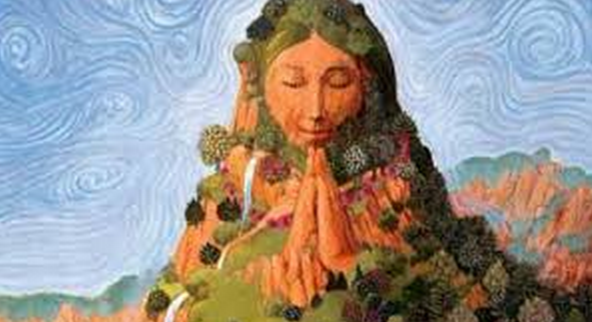- First stories tell us how the world was created. In The Truth about Stories, King tells us two creation stories; one about how Charm falls from the sky pregnant with twins and creates the world out of a bit of mud with the help of all the water animals, and another about God creating heaven and earth with his words, and then Adam and Eve and the Garden. King provides us with a neat analysis of how each story reflects a distinct worldview. “The Earth Diver” story reflects a world created through collaboration, the “Genesis” story reflects a world created through a single will and an imposed hierarchical order of things: God, man, animals, plants. The differences all seem to come down to co-operation or competition — a nice clean-cut satisfying dichotomy. However, a choice must be made: you can only believe ONE of the stories is the true story of creation – right? That’s the thing about creation stories; only one can be sacred and the others are just stories. Strangely, this analysis reflects the kind of binary thinking that Chamberlin, and so many others, including King himself, would caution us to stop and examine. So, why does King create dichotomies for us to examine these two creation stories? Why does he emphasize the believability of one story over the other — as he says, he purposefully tells us the “Genesis” story with an authoritative voice, and “The Earth Diver” story with a storyteller’s voice. Why does King give us this analysis that depends on pairing up oppositions into a tidy row of dichotomies? What is he trying to show us?
Binary thinking, a mindset that takes related concepts but opposite in meaning, is a form of mental opposition that plays a psychological role in how we perceive what is “true.” Binary thinking imposes each idea into their respective black and white forms of laws and facts. In other words, there is only good/truth (which is rewarded) and bad/falsehood (which is condemned), and nothing in between. This rigid way of thinking forces us to view reality in terms of duality, placing identical elements into opposition, and believing that there is only one correct answer allowed in the world.
King purposely aligned the two creation stories side by side and highlighted the dichotomies involved in order to show the dangers of choosing sides and eliminating all other forms of truth once one’s perceived truth is established. Binary thinking has inherent limits that obstruct one to even own the capacity to consider other essential elements, and in turn, blurs our vision of the world to be one that is limited, intolerant, and biased. King understands that the brain is wired by logic and desire of reasoning, and for humans to process a story that cannot be proven by science is virtually impossible without the use of an authoritative voice to tell the “Genesis” story. This prevents any doubts from rising and in return, contributes to the story’s credibility. On the other hand, “The Earth Diver” story is told in a storyteller’s voice to give it animation and spirit, yet runs the risk of skepticism because of its lack of convincibility. Here is when we make the grave mistake of disqualifying other possibilities in order to entertain just one. Whether or not it is human instinct to lean toward a universe governed by a series of hierarchies as opposed to cooperation, we lose sight of the value that the other holds. And that’s the problem with the elemental structure of Western society: we are fixated and swear by our dichotomies for every decision-making process. Like how the author says, “We are suspicious of complexities, distrustful of contradictions, fearful of enigmas” (King 25).
As difficult as it can seem, being consciously aware that binary thinking should progress in a more circular approach is necessary when broadening one’s scope of life. The challenge is to overcome the toxic “all or nothing,” “this or that,” “me or you” mentality, because reality is certainly richer and more complex than what our recognition of the world proposes.
Works Cited
Hilmar-Jezek, Kytka. “Creation Stories.” Waldorf Homeschoolers. 24 Feb. 2011. Web. 17 June 2016. Image.
King, Thomas. The Truth About Stories: A Native Narrative. Toronto: House of Anansi Press Inc, 2003. Print.
Ngo, Robin. “Should We Take Creation Stories in Genesis Literally?” Bible History Daily, 31 Jan. 2016. Web. 17 June 2016.
Schlesinger, Hank. “The Dangers Of Binary Thinking In A Complex World.” Vending Times, 29 Mar. 2014. Web. 17 June 2016.

Hi Sandra,
Great post…I loved how you included the concept of binary thinking, it really helped to solidify the problem with using dichotomies. Would you say we are biased, and that we assume something must be one way or another, and that even if something is told in an authoritative voice, we won’t believe it unless it fits with our mindsets?
You’re right that things are so much more than just black and white…these two stories may seem like opposites but really someone would just say they are both fictional with no scientific meaning, so a third story could be added- a scientific one. Then we have three opposites. How does that work? Clearly some must blend into one another.
Interesting post overall!
Hi Sylvia,
Thank you for your great questions! I think we all have our own belief system influenced and nurtured by our parents and surrounding. So naturally, when we come across a new concept or are exposed to different forms of thinking that challenge our initial beliefs, we cope with the shock factor, then proceed to lean toward whichever side we feel most comfortable with based on our biases. So yes, we’re creatures resistant to change, and prefer to believe in things that require the least adjusting!
Thanks again for your insight,
Sandra